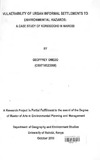| dc.description.abstract | This study - an assessment of vulnerability of urban informal settlements to environmental hazards - was conducted in Korogocho as a response to the emerging world view that recognizes urban informal settlements as areas exposed to numerous environmental hazards and disasters. This is particularly evident in Kenya where the issue of proliferation of informal settlements and urban sprawl has been on the rise. For Korogocho, the Government is implementing a slum upgrading programme in recognition of the challenges of urban informal settlements therein. The main objective of this study was to assess the vulnerability of Korogocho to environmental related hazards.
The study used both primary and secondary sources of data to achieve its objectives. Stratified random sampling was used to select respondents for a questionnaire-based household survey. Other methods of data collection included Focus Group Discussions, key informant interviews and observations. The study employed the use of community-based indicators system (Bollin 2003) for vulnerability assessment at a micro scale level.
The indicators were weighted depending on the hazards, exposure and vulnerability, and coping capacity. The study results revealed that Korogocho is highly vulnerable to disease related hazards, floods, fires and droughts which culminate in famine and general insecurity. The lack of a cogent land-use plan for the area further complicates the problem. The study identified a number of challenges in disaster risk identification, management and reduction in Korogocho.
These include the fact that urban disasters and risks have been neglected, lack of an early warning plan, weak institutional arrangements to support residents, lack of political goodwill and insufficient knowledge, experience and capacity by the residents. The study proposes the need for policy makers and stakeholders in Nairobi City to support the development of appropriate land-use systems for urban areas in addition to supporting research into cheaper but durable housing materials and technology. It recommends the development of a dynamic model that would serve to provide a responsive link between poverty and vulnerability in urban informal settlements. This would go a long way in enhancing the adaptive capacity of slum dwellers in Africa's rapidly expanding cities. | en_US |

